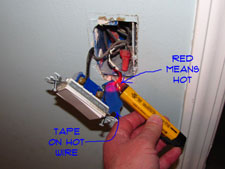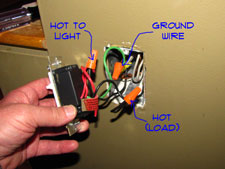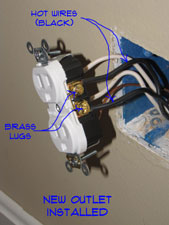Wiring
Dimmer Switch Wiring Diagram
 Locating dimmer switch wires is important. Many dimmers need to be loaded a certain way to work properly. Check the wiring diagram for the dimmer that you have purchased. Do you know which wire is the load (Hot)? You don't, great, what do we do now?
Locating dimmer switch wires is important. Many dimmers need to be loaded a certain way to work properly. Check the wiring diagram for the dimmer that you have purchased. Do you know which wire is the load (Hot)? You don't, great, what do we do now?
Not a big deal use a voltage tester to check which wire is hot. A non contact tester is best. You will have to turn the power back on. Make sure the wire nuts are on the exposed ends of the wires. Got it now? Put a piece of tape on it to tag it for now.
Make sure the switch is in the off position. One wire leading to the switch should be hot with the switch off. The other wire should not have any power. Are both of them hot? Then the switch is not off. Tag the hot wire before you remove the wires. Turn the breaker back off, remember.
One issue with dimmer switches is that they are bigger than normal switches. You may need to push the wires back into the box a little tighter to make room. Did you think that wiring a dimmer switch would not be any work at all?
How Does a Dimmer Switch Work?
This article needs copy
How To Replace a Dimmer Switch
 Is wiring a dimmer switch something you can do? Maybe the switch is old and worn out looking. In the evening the light is too bright, why not replace it with a dimmer switch? Rarely, a switch may go bad, and need to be replaced. Light switches are the easiest of all items to wire. Only one wire is involved, unless it has a grounding lug and then you have two. The Hot (Black) and the Ground (Bare or Green).
Is wiring a dimmer switch something you can do? Maybe the switch is old and worn out looking. In the evening the light is too bright, why not replace it with a dimmer switch? Rarely, a switch may go bad, and need to be replaced. Light switches are the easiest of all items to wire. Only one wire is involved, unless it has a grounding lug and then you have two. The Hot (Black) and the Ground (Bare or Green).
For related information see the articles 'Wiring a Three Way Switch', 'How To Wire a Light Switch' and 'Troubleshooting Wiring Problems'.
Obtain your desired dimmer switch before you begin. This is where you will have a problem. I must warn you that there are a lot of choices for dimmer switches. You may need to involve your spouse in this decision. I know, it's a hassle, but it takes less time than going back a second time with both of you.
Find a dimmer switch that suits you and you're ready to go. They can vary quite a bit in cost. You are mostly paying for the look on the expensive ones.
Wiring a Dimmer Switch - Information
What Can You Save?
Prices will vary but it will probably cost between $40 and $150 to have someone come out and replace a light switch for you. New dimmer switches can run anywhere from $5 to, well, a lot more. Your savings could be between $35 and $145, not bad for fifteen minutes of work wiring a dimmer switch.
How Hard Could It Be?
Wiring a dimmer switch is not that difficult.
Check the Simple Things!
We have covered this topic for completeness. If you dimmer switch is toast, then replacing it is about your only option. Are you just upgrading, then you still need to replace the old switch.
What Can Go Wrong?
Electrical shocks can cause severe injury and even death. Be careful, make sure the power is off. Always double check, turn the breaker off and then use a tester to make sure nothing is hot. It is possible for more than one circuit to be fed through a single box. Faulty or incorrect wiring can cause dead shorts and fires. Make sure you understand how to hook something up before you attempt it.
Troubleshooting Dimmer Switch Wiring
Dimmer switches are wired the same way as regular switches. If you are having trouble with a switch you want to see the article 'Wiring a Light Switch', for some troubleshooting tips.
Locating Dimmer Switch Problems - The first thing you will need to do is determine what is wrong with the dimmer switch. Is it the switch that is bad? This article will help you track down the problem and locate the correct solution.
How Does a Dimmer Switch Work - It is helpful to know how dimmer switches work. This will help you to determine whether the symptoms or problems your are experiencing are related to the actual switch.
Types of Dimmer Switches - If you need to replace your dimmer switch, you may be suprised at the variety of options theres are for replacements. What type of dimmer switch will match the wiring you have in your home? Consult this article before you replace your existing dimmer Switch.
Removing a Dimmer Switch – This step discusses taking out the old switch before you install the new one.
Dimmer Switch Wiring Diagrams – Finding the right wires with a standard two pole switch is fairly simple. Find out how and what to do if it is not a two pole switch.
WARNING!! Make Sure the Power is OFF!!! BEFORE You Work on Electrical Devices!!!
Installing a Dimmer Switch
 With the proper wires located, you can begin installing a dimmer switch. Take note of the orientation of the switch wires. It is likely that the dimmer switch that you purchased needs to be turned a certain way. Check the instructions. I know you hate to do that, but go ahead, wait until no one is looking. Turn the switch the right way.
With the proper wires located, you can begin installing a dimmer switch. Take note of the orientation of the switch wires. It is likely that the dimmer switch that you purchased needs to be turned a certain way. Check the instructions. I know you hate to do that, but go ahead, wait until no one is looking. Turn the switch the right way.
Bend a hook in the wires or strip them the proper distance if the switch has hold down plates on the lugs. The ground wire is always wrapped around the green screw. Check the installation instructions for the switch you purchased to be sure.
Hook the wires up to the lugs on the switch. Turn the power back on to make sure it is working properly. Does the light work? Yes, great! You're almost done wiring a light switch. Turn the power back off and wrap some electrical tape around the lugs. Screw the switch back into the box and install the cover plate. That's all there is, congratulations!
How To Ground an Outlet
Outlets without grounding can be a safety issue. Electrical shocks can result when an outlet is not properly grounded. Newer home built under modern codes are required to have grounding for all electrical outlets.
Older homes may not have grounded receptacles. Using adapters is not a good practice, due to the fact that they still need to be grounded. You can ground to the box if it is hooked to metal conduit.
This is rare in residential homes. The ground wire is a safety feature the prevents electrical shock in the event of a neutral failure.
Homeowners that have outlets without grounding may want to consider upgrading their wiring. This is a big undertaking and beyond the scope of this article. You will need to hire an electrician. It is possible that you can get grounding installed on certain key outlets, such as those that need GFCI protection. Again you will need to consult an electrician or develop basic wiring skills of your own.
Testing an Outlet Ground
You can use an inexpensive circuit tester to check to see if an outlet is grounded. Another option is an outlet receptacle tester. These cost a bit more, but they test for multiple conditions.
A circuit tester lights up when there is power traveling between the two contact points. In a grounded outlet the small slot should be the power, the larger slot is the nuetral. Normally, when power is used, it travels from the hot, through the device and back through the neutral. If for some reason the neutral fails, the ground is used to convey the power back safely.
An outlet receptacle tester has three lights on it the will light up in different combinations, depending on how the outlet is wired. One of the things they test for is 'open ground' and 'open neutral'. Either of these situations is not desirable. For complete instructions on testing an outlet, see the article 'How To Test an Outlet'.
Fixing an Outlet Ground
When an outlet shows 'no ground' or 'open ground' it may just be a problem at the box. A loose wire or an incorrectly wired receptacle could be the problem. If that is the case, it is not too difficult to fix the wiring. It may just be a matter of switching the wires or connecting the outlet to the ground wire.
For instructions on wiring an outlet, see the article 'How To Wire a Receptacle'. This article shows the correct placement of wires to have the outlet work properly.
Adding a Ground Wire
A common problem in older houses is wiring that does not have a ground wire. As mentioned above, the ground wire is only used when there is a failure or some distruption in the current going back through the neutral. Years ago it was not considered necessary to have a ground wire. Ground wires were added as safety features and are now part of the electrical code.
Installing New Wiring
How To Install a GFCI Outlet
Before you begin an electric outlet installation, make sure the power is off. Turn off the breaker and put a piece of tape over it. Double check for power with a tester. Newer plugs all have three wires attached to them. A Hot (Black), Neutral (White) and a Ground (Bare or Green).
How a GFCI Outlet Works
Unhook the wires from the old receptacle, noting the orientation. Attach the ground wire to the green ground lug. Then attach the neutral to the silver side of the outlet. Lastly, attach the hot wire to the brass side of the outlet. This coding system is fairly universal. Depending on the light you have, you may have to look close to tell between the silver and brass lugs.
 Some outlets may allow you to push the hot and neutral wires into the back of the outlet. There are round holes there. You strip the wire the proper distance, keeping it straight and simply push the wire in until the insulation touches the back of the receptacle. Tighten the screws and that is all there is to it. These push connections are sometimes only good for one size wire, such as 14 gauge. To hook to the lugs you will have curl the wires and hook them around the lugs. Tighten them snugly.
Some outlets may allow you to push the hot and neutral wires into the back of the outlet. There are round holes there. You strip the wire the proper distance, keeping it straight and simply push the wire in until the insulation touches the back of the receptacle. Tighten the screws and that is all there is to it. These push connections are sometimes only good for one size wire, such as 14 gauge. To hook to the lugs you will have curl the wires and hook them around the lugs. Tighten them snugly.
For outlets that had four wires attached you will need to reattach all of them. The extra two wires are to feed the next outlet in the circuit. As a safety precaution you want to wrap electrical tape around the lugs. This is especially needed if you have metal boxes.
The final step to install electrical outlets is to put it back together. Use the tester to make sure it is working. Attach the outlet back to the box and then install the cover plate. Got young children? Put the safety plugs back in. Congratulations! You can plug the lamp back in. It's time to move on to other electrical or home repairs.


